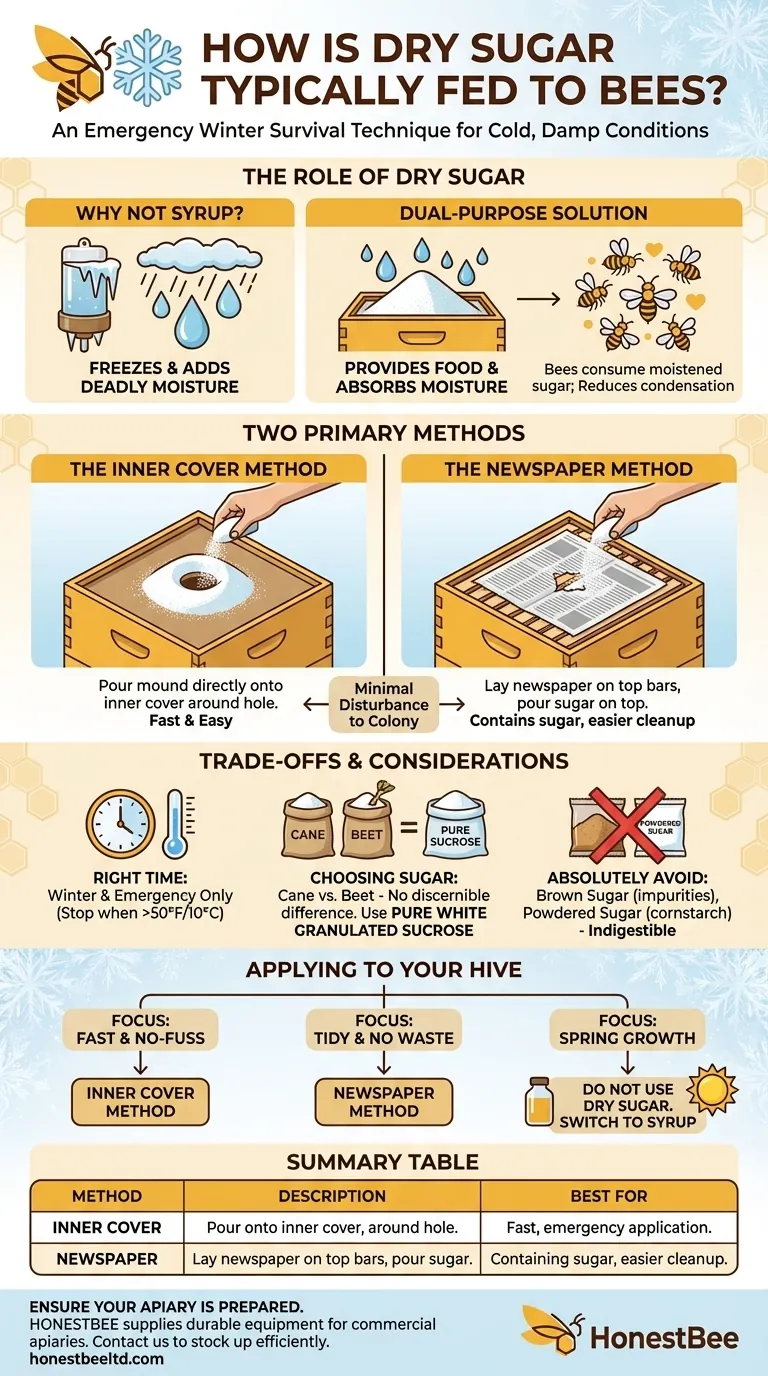In an emergency, dry sugar is typically fed to bees by pouring it directly onto the inner cover or by placing it on a sheet of newspaper laid across the top bars of the hive. This method is used primarily during cold winter months when feeding liquid syrup is not a viable option. It serves as a crucial survival ration to prevent starvation.
Dry sugar feeding is more than just providing food; it's a winter survival technique. Its primary purpose is to offer an emergency carbohydrate source that simultaneously helps absorb excess moisture inside the hive, protecting the bees from cold, damp conditions.

The Role of Dry Sugar in the Hive
Dry sugar feeding is a specific tool for a specific problem: winter survival. It is not a substitute for the liquid sugar syrup used during other times of the year.
Why Not Just Use Sugar Syrup?
In cold weather, liquid sugar syrup presents two major problems. It can freeze in the feeder, making it inaccessible to the bees. More importantly, it introduces significant moisture into a hive that is already struggling to manage condensation.
Excess moisture is a greater threat than cold in the winter. Water droplets can rain down on the cluster, chilling and killing the bees.
Food and Moisture Control in One
Dry sugar solves both problems. It provides a stable food source that won't freeze, and the sugar crystals are hygroscopic, meaning they absorb ambient moisture from the air.
Bees can then consume the slightly moistened sugar. This dual-purpose action—providing food while reducing deadly condensation—makes it an invaluable tool for winter management.
Two Primary Methods for Dry Feeding
Applying dry sugar is simple and requires minimal disturbance to the colony. Both methods achieve the same goal.
The Inner Cover Method
This is the fastest and easiest technique. You simply remove the telescoping outer cover and pour a mound of plain white table sugar directly onto the inner cover, forming a pile around the central hole.
The bees will crawl up through the hole to access the sugar as needed. This method is ideal for a quick emergency application.
The Newspaper Method
For better containment, many beekeepers prefer this method. A single sheet of newspaper is laid directly on top of the frames of the uppermost hive box.
A small hole can be torn in the center to encourage access, and the sugar is then poured onto the newspaper. The paper prevents sugar from sifting down between the frames and makes cleanup easier in the spring.
Understanding the Trade-offs and Considerations
While effective, dry sugar feeding is not a universal solution. It's crucial to understand its limitations.
The Right Time for Dry Sugar
Dry feeding is strictly a winter and emergency practice. It provides calories for survival but does not stimulate brood rearing or colony expansion the way sugar syrup does. Once temperatures are consistently above 50°F (10°C), you should switch to liquid feed if supplemental feeding is still required.
Choosing Your Sugar: Cane vs. Beet
You may encounter debates about using cane sugar versus beet sugar. While some beekeepers prefer cane sugar due to concerns about genetically modified beet crops, extensive testing has found no discernible difference in bee health or nutrition between the two.
The critical factor is that you use pure, white granulated sucrose.
What to Absolutely Avoid
Never use brown sugar or powdered (confectioner's) sugar. Brown sugar contains molasses and other impurities that bees cannot properly digest, which can cause dysentery.
Powdered sugar almost always contains cornstarch to prevent caking, and this starch is indigestible to bees. Stick to plain white granulated sugar.
Applying This to Your Hive
Choosing the right feeding strategy depends on your specific situation and management style.
- If your primary focus is a fast, no-fuss emergency feed: Use the inner cover method for its unmatched simplicity and speed.
- If your primary focus is keeping the hive tidy and preventing waste: Use the newspaper method to contain the sugar and simplify spring cleanup.
- If your primary focus is stimulating colony growth in spring: Do not use dry sugar; switch to a 1:1 sugar-to-water syrup once the weather is consistently warm.
Using the correct feeding method at the right time is a cornerstone of responsible beekeeping that directly contributes to the health and survival of your colony.
Summary Table:
| Method | Description | Best For |
|---|---|---|
| Inner Cover | Pour sugar directly onto the inner cover around the central hole. | Fast, emergency application. |
| Newspaper | Lay a sheet of newspaper on top bars, pour sugar on top. | Containing sugar, easier cleanup. |
Ensure your apiary is prepared for winter with the right supplies. HONESTBEE supplies durable, high-quality beekeeping equipment and feeders to commercial apiaries and distributors. Let our wholesale-focused operations help you stock up efficiently. Contact our team today to discuss your needs and keep your colonies thriving.
Visual Guide

Related Products
- Professional Dual-End Stainless Steel Hive Tool for Beekeeping
- HONESTBEE Advanced Ergonomic Stainless Steel Hive Tool for Beekeeping
- Professional 3-Bar Frame Grip with Integrated Hive Tool
- Beehive Handle and Frame Rest Cutting Machine: Your Specialized Hive Machine
- Yellow Plastic Bucket Pail Perch for Beekeeping
People Also Ask
- What should beginners consider when purchasing beekeeping equipment? A Guide to Essential Starter Gear
- What are the features of a regular hive tool? The Essential Multi-Tool for Every Beekeeper
- What is a hive tool and what are its uses? Master Your Hive Inspections with the Essential Beekeeper's Tool
- How should beekeepers handle bees when using a hive tool? Master Calm, Deliberate Techniques
- What is a hive tool used for in beekeeping? Your Essential Guide to Hive Management



















